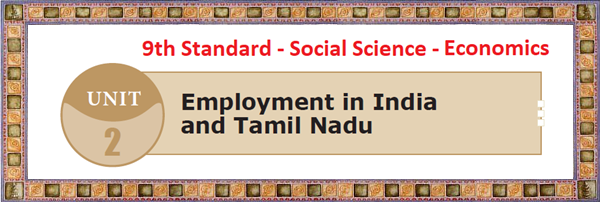Tamil Nadu Board 9th Standard Social Science - Economics Unit 2: Book Back Answers and Solutions
This post covers the book back answers and solutions for Unit 2 – Economics from the Tamil Nadu State Board 9th Standard Social Science textbook. These detailed answers have been carefully prepared by our expert teachers at KalviTips.com.
We have explained each answer in a simple, easy-to-understand format, highlighting important points step by step under the relevant subtopics. Students are advised to read and memorize these subtopics thoroughly. Once you understand the main concepts, you’ll be able to connect other related points with real-life examples and confidently present them in your tests and exams.
By going through this material, you’ll gain a strong understanding of Economics Unit 2 along with the corresponding book back questions and answers (PDF format).
Question Types Covered:
- 1 Mark Questions: Choose the correct answer, Fill in the blanks, Identify the correct statement, Match the following
- 2 Mark Questions: Answer briefly
- 3, 4, and 5 Mark Questions: Answer in detail
All answers are presented in a clear and student-friendly manner, focusing on key points to help you score full marks.
All the best, Class 9 students! Prepare well and aim for top scores. Thank you!
Topic: Unit 2. EMPLOYMENT IN INDIA AND TAMIL NADU
I. Choose the correct Answer
9th SocialII. Fill in the blanks
9th SocialIII. Find out the correct statement
9th SocialIV. Match the following
9th SocialV. Answer the following briefly
- The labour force is defined simply as the people who are willing and able to work.
- It determines the economic growth.
- Because they are not physically fit to undertake productive occupation.
- Primary sector
- Secondary sector
- Tertiary sector.
VI. Answer all the questions given under each caption
Primary Sector
- Agriculture, forestry, animal husbandry, fishing, etc.,
Secondary Sector:
- Manufacturing, small and large scale industries and constructional activities.
Tertiary Sector:
- Transport, insurance, banking, trade, communication, government activities.
- In recent years, there has been a change in the employment pattern and this has helped the employers to develop more flexible working patterns among their employees.
- Increasing self - employment.
- Firms using fewer full time employees and tending to offer more short-term contracts.
- There has been a growth in part time employment. This may be due to lifestyle of the people.
|
ORGANISED SECTOR |
UNORGANISED SECTOR |
|
* Organized sectors are registered. * Terms are fixed and regular... * Central and state governments, bank, railways, insurance are some of organized sectors. * The employees have job security. * They receive higher wages. * Good salary, fixed working hours and provides medical allowances are some benefits. |
* Unorganized sectors are not registered. * Terms are not fixed and regular. * House hold manufacturing and small - scale industries are some of unorganized sectors. *Employees do not have job security. * They do not enjoy any special benefits. * Low paid, no fixed working hours and no medical allowances. |
|
PUBLIC
SECTOR
|
PRIVATE
SECTOR
|
|
* Service motive. * Government owns the assets. *Wages are paid by the government. *Ex., NLC, BSNL, ICF. |
* Profit motive. * Private individuals own the assets. * Wages are paid by the owner of private enterprises. *
Ex., TATA, TVS, Reliance. |









0 Comments:
Post a Comment